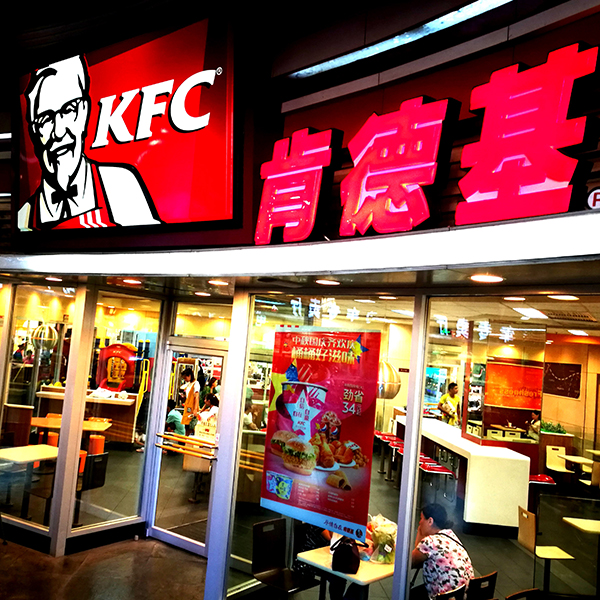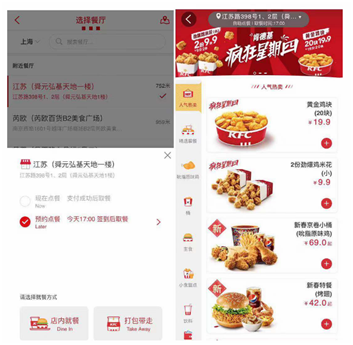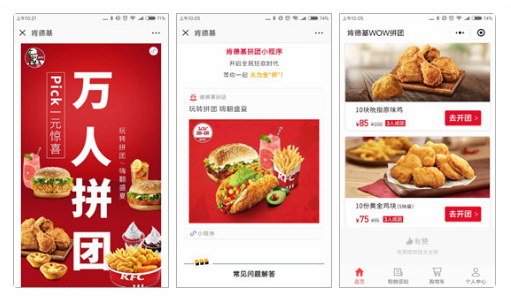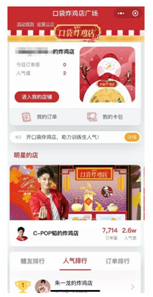Ecommercestrategychina.com uses cookies and other technologies to provide you a better browsing experience. You can get more information regarding the use of cookies, or decline it whenever by clicking Privacy Policy. By using this site or clicking “Okay”, you give us the consent to the use of cookies.
OKAY
It has been 32 years since KFC, the American fried chicken brand, entered the Chinese market, and it is by far the most popular fast food chain in China. The key to KFC’s success in the country is not only the customisation of menus to local tastes but also the steady digitalisation as well as the upgrading of marketing for young people. In this article, we explore how KFC has improved its localisation strategy by embracing digital innovation and social media.
Mobile experience
• Self-help ordering on the app and Mini Program
KFC was early to explore the delivery services. Initially, takeaway services were launched by phone and massively promoted it via TV advertising. Then, they started the self-built online order website. As the food-delivery apps, such as Alibaba’s Eleme and Meituan, have boomed in recent years, KFC took the opportunity to collaborate with them and approach a broader customer bases. In addition to the online delivery layout, it has improved the in-store experience by providing kiosks for self-ordering and facial recognition payment.
To promote its app, it integrated the ordering function into the mobile devices to increase traffic from the offline channels. Based on Location-based service (LBS), it can detect the nearest shop and allow customers to choose the pick-up time, freeing them from waiting and long queues during peak hours. By signing in, customers are also connected to the online membership system, where they can earn credits to exchange coupons and receive other services. When the WeChat Mini Program emerged as an alternative to the stand-alone app, KFC used the WeChat ecosystem to reach its massive user base and is suitable for those who do not want to download or install the app.

Community-based e-commerce on Mini Program
• Group buying mode
Community-based e-commerce is a rising trend. KFC has been tapping into this space as well. Like many local start-ups, KFC has begun to experiment with the group-buying mode. It is an effective way to drive sales by getting users to rally their friends through social networks to get a better deal. For example, KFC launched its WOW group buying campaign in August 2018, which allows consumers to purchase virtual coupons at a very affordable group price and use them in any physical store. It was sold out within one hour.

• Interactive game campaign
Currently, KFC has 5 Mini Programs with different focuses on WeChat. The Mini Store, for example, shows its efforts at gamification. Consumers can open virtual stores, whereby they invite friends to buy special coupons and get rewards. It also ranks the stores of celebrities on the homepage (mainly the spokespeople of KFC) according to the orders they completed, thus significantly stimulating the attention and engagement of fan groups while increasing the sales.

Membership system
• Personalised services available on app
KFC wants to implement group-buying and self-ordering on the Mini Program to lock in new customers. At the same time, the app is the primary place to enhance customer relationship management. In this regard, two features are very creative and impressive.
1. Instore jukebox
On the KFC app, customers can request songs to play in the store. It will be a unique experience for users to hear their favourite songs being played during the meal.
2. Reading platform for parents and children
Instead of a conventional membership system, the KFC app not only fulfils basic needs but also embodies brand connotation. For two years, KFC had been offering a reading platform for parents and children on its app. This section enables online reading and the purchase of some bilingual stories, and also serves as registration for relevant sharing events. It is reported that KFC had donated over 18 million books to left-behind children (children who remain in rural areas while their parents leave to work in urban areas) nationwide between April 2015 and the end of 2018.
The financial report of Tricon Global Restaurant, KFC’s parent company, shows that the number of KFC members is more than 160 million and that online sales are up by 11% of sales processed online (86% of total sales). The diversified scenarios on the mobile phone are just a small part of the digitisation of KFC. Smart store initiatives and the optimisation of the kitchen system will help KFC to maintain its competitiveness in China.
What can we learn from KFC? For Western brands trying to enter China, it is definitely a shining example of how you can keep up with the latest digital trends. And moreover, the overall customer experience is critical to successful localisation, especially in the Chinese market.
Please Login to add comments.

$9.99 $19.98

$9.99 $19.98